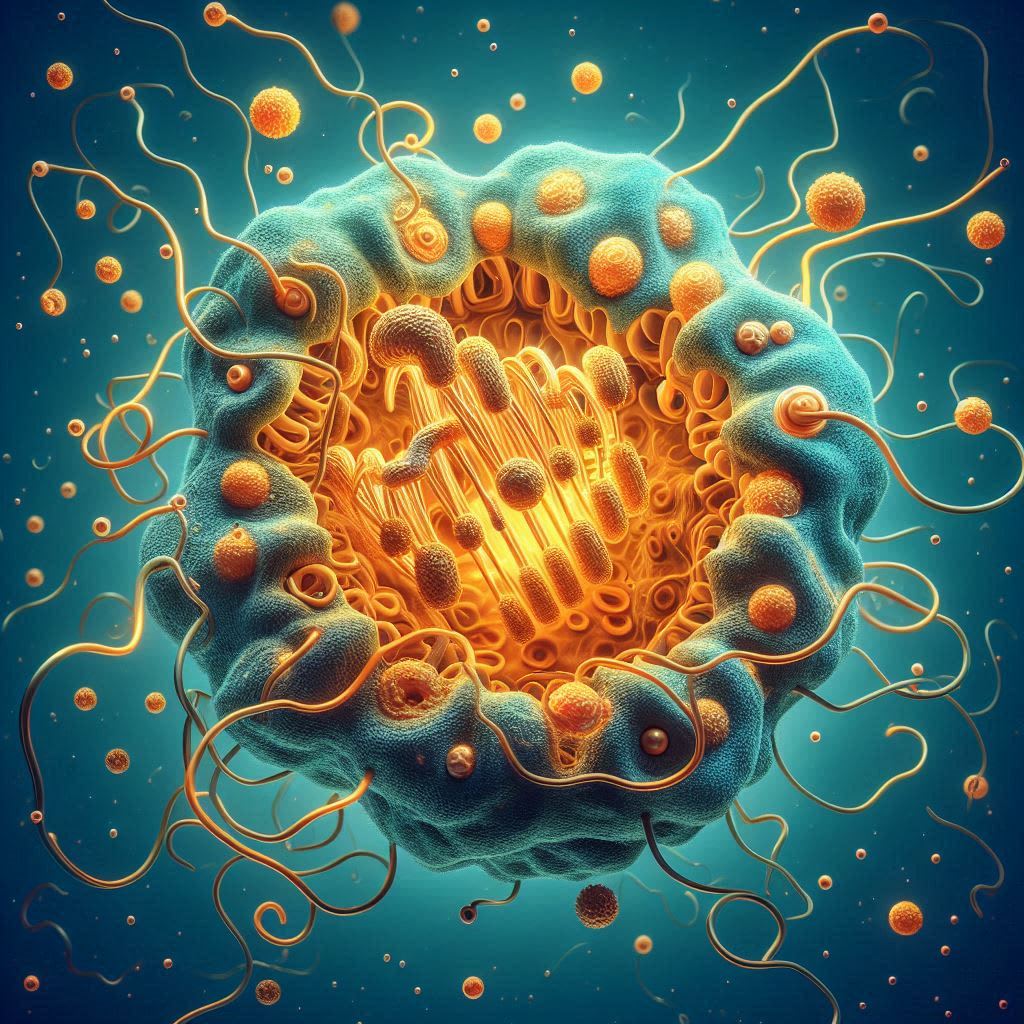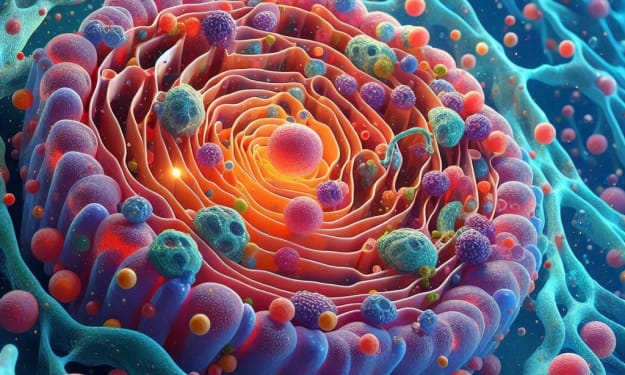Unlocking the Mystery: The Golgi Apparatus and Wilson's Disease
Delving into the cellular battleground where a tiny organelle fights copper overload.

The Silent Defender: How the Golgi Apparatus Battles Copper Overload in Wilson's Disease
Imagine a tiny factory within your cells, a meticulous sorting and packaging center for proteins and lipids. This is the Golgi apparatus, an unassuming organelle that plays a critical role in cellular function. But what happens when this factory malfunctions, leading to a toxic metal buildup? This is the story of Wilson's disease, a rare genetic disorder where the Golgi apparatus becomes unwittingly embroiled in a battle against copper overload.
The Golgi Apparatus: Packaging Maestro and Cellular Gatekeeper
Before diving into Wilson's disease, let's understand the Golgi apparatus's everyday job. Composed of flattened sacs called cisternae, this organelle acts like a sophisticated cellular post office. It receives protein and lipid molecules from the endoplasmic reticulum (ER), another cellular factory. These molecules are often like raw materials, needing modifications before they can be shipped to their final destinations.
The Golgi apparatus, with its team of specialized enzymes, modifies these molecules in several ways. It can add or remove sugar molecules (glycosylation), attach phosphate groups, or clip off unnecessary bits. These adjustments are crucial for the proteins and lipids to function properly at their designated locations. Finally, the Golgi apparatus sorts the modified molecules into vesicles, tiny membrane-bound packages, ensuring they reach the correct cellular address – the cell membrane, lysosomes, or even secreted outside the cell.
But the Golgi apparatus does more than just package. It also acts as a cellular gatekeeper, ensuring the proper balance of molecules within the cell. This gatekeeping function becomes especially vital when it comes to copper, a trace element essential for various bodily functions.
The Culprit: A Faulty Copper Chaperone and a Cellular Siege
Now, let's shift gears and discuss Wilson's disease. This autosomal recessive disorder affects roughly 1 in 30,000 people globally, typically presenting in adolescence or young adulthood [1]. It is caused by mutations in the ATP7B gene. This gene codes for a protein called ATP7B copper-transporting ATPase 2, also known as the Wilson disease protein (WDP). Normally, WDP resides within the Golgi apparatus of liver and brain cells. It acts as a copper chaperone, helping copper bind to ceruloplasmin, a protein that transports copper throughout the body.
However, in Wilson's disease, the mutated ATP7B protein malfunctions. It can't effectively shepherd copper into ceruloplasmin. As a result, copper accumulates within the Golgi apparatus, disrupting its delicate sorting and packaging machinery. This not only hinders the proper delivery of other cellular materials but also allows excess copper to leak out, wreaking havoc on the surrounding cells. The buildup of copper in the liver and brain leads to a cellular siege, causing significant damage over time.
The Silent Threat: From Liver Damage to Neurological Issues
The liver is the primary battleground in Wilson's disease. As copper accumulates, it damages liver cells, leading to inflammation, scarring (cirrhosis), and eventually liver failure. Symptoms can be vague at first, including fatigue, nausea, and abdominal pain. Later, jaundice (yellowing of the skin and eyes) and fluid buildup in the abdomen (ascites) may occur.
But the war doesn't stop there. Copper can also travel to the brain, causing neurological damage. This can manifest as tremors, difficulty with coordination, speech problems, and even psychiatric disturbances. The characteristic Kayser-Fleischer rings, a copper deposition around the cornea visible on eye examination, are a telltale sign of Wilson's disease.
Fighting Back: Taming the Copper Beast
Fortunately, early diagnosis and treatment can significantly improve the quality of life for people with Wilson's disease. Doctors rely on a combination of blood tests, liver function tests, genetic testing, and sometimes even a liver biopsy to confirm the diagnosis.
The mainstay of treatment involves chelating agents, medications that bind to copper and help remove it from the body. Penicillamine is a traditional chelator, but newer options like trientine and tetrathiomolybdate are also used. Treatment is lifelong, and regular monitoring is crucial to ensure copper levels are under control.
Beyond the Basics: Research Frontiers in Wilson's Disease
While chelation therapy is effective, researchers are actively exploring new avenues for managing Wilson's disease. Gene therapy, a technique that aims to correct the faulty ATP7B gene, holds immense promise. Early clinical trials, like the phase II trial using adeno-associated virus vectors to deliver a functional ATP7B gene, have shown encouraging results [2]. However, further research is needed to ensure its safety and efficacy for widespread use.
Another exciting area of research focuses on identifying biomarkers – measurable indicators of disease severity or response to treatment. A recent study identified a potential biomarker using metabolomics, the analysis of small molecules within cells This could allow for personalized treatment plans based on an individual's unique metabolic profile, potentially reducing side effects and improving treatment outcomes. Additionally, research on gene editing techniques like CRISPR-Cas9 holds promise for permanently correcting the faulty ATP7B gene, offering a potential cure for Wilson's disease in the future.
Living with Wilson's Disease: A Multifaceted Approach
While medication is the cornerstone of treatment, managing Wilson's disease often requires a multifaceted approach.
Dietary Management: Following a low-copper diet can help reduce copper intake and ease the burden on the body's copper removal systems. This may involve limiting foods rich in copper, such as organ meats, shellfish, chocolate, and nuts.
Support Groups and Resources: Connecting with support groups or organizations like the Wilson Disease Association International can provide invaluable emotional support, access to educational resources, and a sense of community for patients and their families.
The Golgi Apparatus: A Silent Hero and a Target for Future Therapies
The Golgi apparatus may seem like a behind-the-scenes player in the cell, but its role in Wilson's disease highlights its crucial importance. Understanding how this organelle functions and how it malfunctions in disease paves the way for better diagnostics and treatment strategies. As research progresses, the future looks brighter for individuals battling copper overload. The Golgi apparatus, once a silent defender, may become a target for future therapies aimed at restoring its proper function and alleviating the burden of Wilson's disease.
About the Creator
suren arju
Hi there! I'm Suren, your startup guide. Entrepreneur, writer, dreamer - I share insights, tips & stories to fuel your startup journey. Ready to explore, learn & win together? Join me & let's redefine how we launch, learn & leap!





Comments
There are no comments for this story
Be the first to respond and start the conversation.